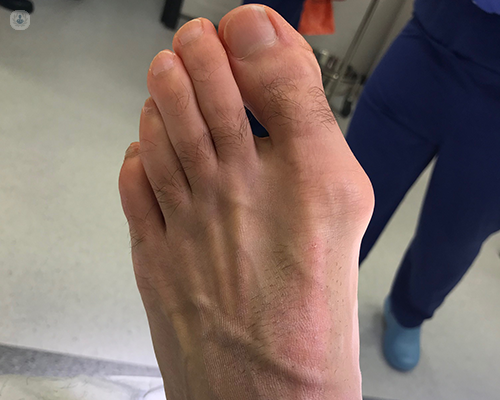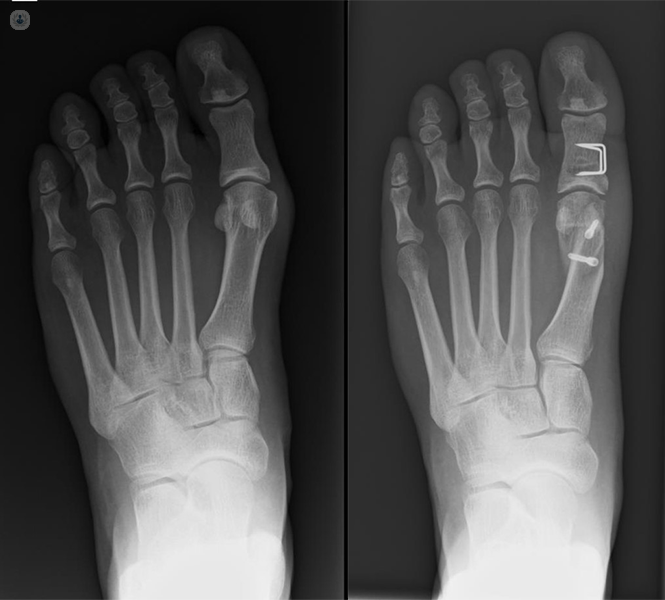Bunions: why they happen and how to get rid of them
Escrito por:Bunions, while not uncommon, can be quite problematic and negatively impact several aspects of a person’s quality of life. Whether it’s for appearance, discomfort or inability to perform activities, many people aim to have bunions removed and orthopaedic specialists such as Mr Stefan Weitzel, a consultant orthopaedic foot & ankle surgeon, know how to do just that. Read on for his expert advice and knowledge about bunion causes as well as your non-surgical and surgical options.

What are bunions and what causes them?
Effectively, a bunion is a prominent bump on the inner aspect of the big toe joint.
There are three main causes:
- Genetics: Bunions do run in families. They’re more likely to be passed down, but not necessarily straight from parents to children – they can be passed on from more distant family members and may skip generations.
- Footwear: Fashionable or tight-fitting footwear that squeezes toes together puts pressure on the big toe joint. This is particularly the case when wearing heels as the body load is pushed onto the forefoot.
- Age: As we get older, the foot’s ability to balance muscles gets poorer. Also, the ability to compensate the external pressures on the foot lessens and the forefoot gets wider – all these things together increase the likelihood of a bunion.
Bunions can occur at any age once the feet have stopped growing - from teenagers and young adults to older adults. The younger someone is, the more likely it is that genetics play a role in forming the bunion.
What are the non-surgical treatments?
Like any other musculoskeletal condition, bunions can be managed non-operatively. The following approaches can be done to alleviate symptoms but usually, they’re only effective for a short to medium period, not long-term.
- Footwear modification: This means finding more comfortable footwear, which is generally wider fitting shoes. These may seem difficult to find but there are now several companies that specialise in wider fitting footwear.
- Inserts or orthotics: These are designed to cushion and support the normal foot arches and may help with bunion pain.
- Bunion splints and pads: These special bunion applications can be worn day and night, but some people prefer to wear them only at night and others only during the day. These devices either protect the bunion against external shoe pressure or pull the bunion straight.
- Painkillers: These can relieve flare-ups of pain.
When is surgery necessary?
Surgery is required when non-operative measures are no longer beneficial. Very occasionally, people need a bunion operation but have no actual bunion pain but lesser toe deformities that are caused by the pressure from the big toe pushing across.
What does surgery involve?
Simply shaving off the bunion is a surgical method that is typically not very effective or successful, but it used to be very popular. Nowadays, to achieve an effective and successful correction of the foot, we aim to reduce the size of the bump and narrow the width of the forefoot. This is usually achieved by cutting and realigning the bones (midfoot and toe bones) – this is referred to as an osteotomy procedure.
The following two images compare a foot before and after surgical bunion treatment. In the pre-op image (left), the midfoot and toe bones form an angle and the head of the midfoot bone protrudes on the inner side constituting the bunion. In the post-op image (right), the midfoot & toe bones are aligned in a straighter line, the foot width has narrowed and the bunion prominence has gone.

Sometimes, when the problem is very severe, or when there’s arthritis involved, one may need to consider fusing joints. In other words, this means stiffening joints. However, most patients will benefit from a single or double osteotomy (one or two bones are cut and reshaped), which means the big toe joint remains mobile.
Is surgery painful?
There is some pain from surgery but it can be managed. Bunion surgery is a day case operation that can be performed using general anaesthesia (which puts the patient under controlled unconsciousness) or regional anaesthesia (which involves an injection to numb the operative area and the patient is left awake).
Generally, we routinely use nerve block injections. This injection is done during the operation and this numbs the pain for up to 24 hours following surgery. After that, we treat the pain with painkiller tablets but after 5-7 days most patients no longer need any pain medication.
What does aftercare involve?
Post-operatively patients have a bandage on their feet and will have a series of outpatient appointments during which the wound is checked. They will also use solid-soled postoperative shoes that allow protected weight-bearing. Some patients may benefit from crutches to get around especially if patients decide to have both feet done in one sitting.
It usually takes four to eight weeks until patients can walk normally in wide-fitting footwear such as trainers, but return to work should be possible for most from two to four weeks postoperatively. However, getting back to sports (e.g. running or cycling) can take a little longer – around six to twelve weeks. Driving should generally be delayed until the bones have healed around six weeks.
Swelling can persist for longer and, therefore the return to fashionable or tighter fitting work shoes can be delayed until eight to twelve weeks.
How successful is bunion surgery?
The success rate of bunion surgery is very high and in the region of 90% of patients are satisfied or very satisfied with the outcome.
Despite the high success rate, as with any surgical procedure, there are some potential complications that can usually be treated successfully.
- Wound healing problems.
- Scar hypersensitivity or reduced skin sensation
- Persisting pain and recurring bunion
- Joint stiffness
- Metalwork problems (less than 5% of patients need metal work removal, for most the screws and pins can remain in situ and cause no problems).
For more advice from Mr Weitzel and to find a solution to your bunions, you can arrange a face-to-face or online video consultation – get started by visiting his profile to learn more


